Therapeutic Communication Skills & Collaboration in Patient Care
VerifiedAdded on 2023/04/25
|8
|2311
|381
Essay
AI Summary
This essay explores the significance of therapeutic communication skills and inter-professional collaboration in achieving patient-centered care and ensuring safe nursing practices. It defines therapeutic communication as a face-to-face process focusing on patients' physical and emotional health, emphasizing verbal and non-verbal communication components such as physical, social, psychological, and temporal aspects. The essay identifies barriers to effective communication, including language differences, cultural disparities, and care setting limitations, which can impede information exchange between nurses and patients. Furthermore, it highlights the role of inter-professional collaboration in reducing health-related issues and improving patient-centered care through team-based approaches. Strategies for enhancing inter-professional collaboration, such as fostering respect, collaboration, and shared decision-making, are discussed, emphasizing the importance of a common language and coordinated efforts among healthcare providers. The essay concludes that therapeutic communication and inter-professional collaboration are vital for understanding patients' needs, delivering quality care, and promoting positive health outcomes.

Therapeutic communication skills and inter-professional collaboration
Paraphrase This Document
Need a fresh take? Get an instant paraphrase of this document with our AI Paraphraser
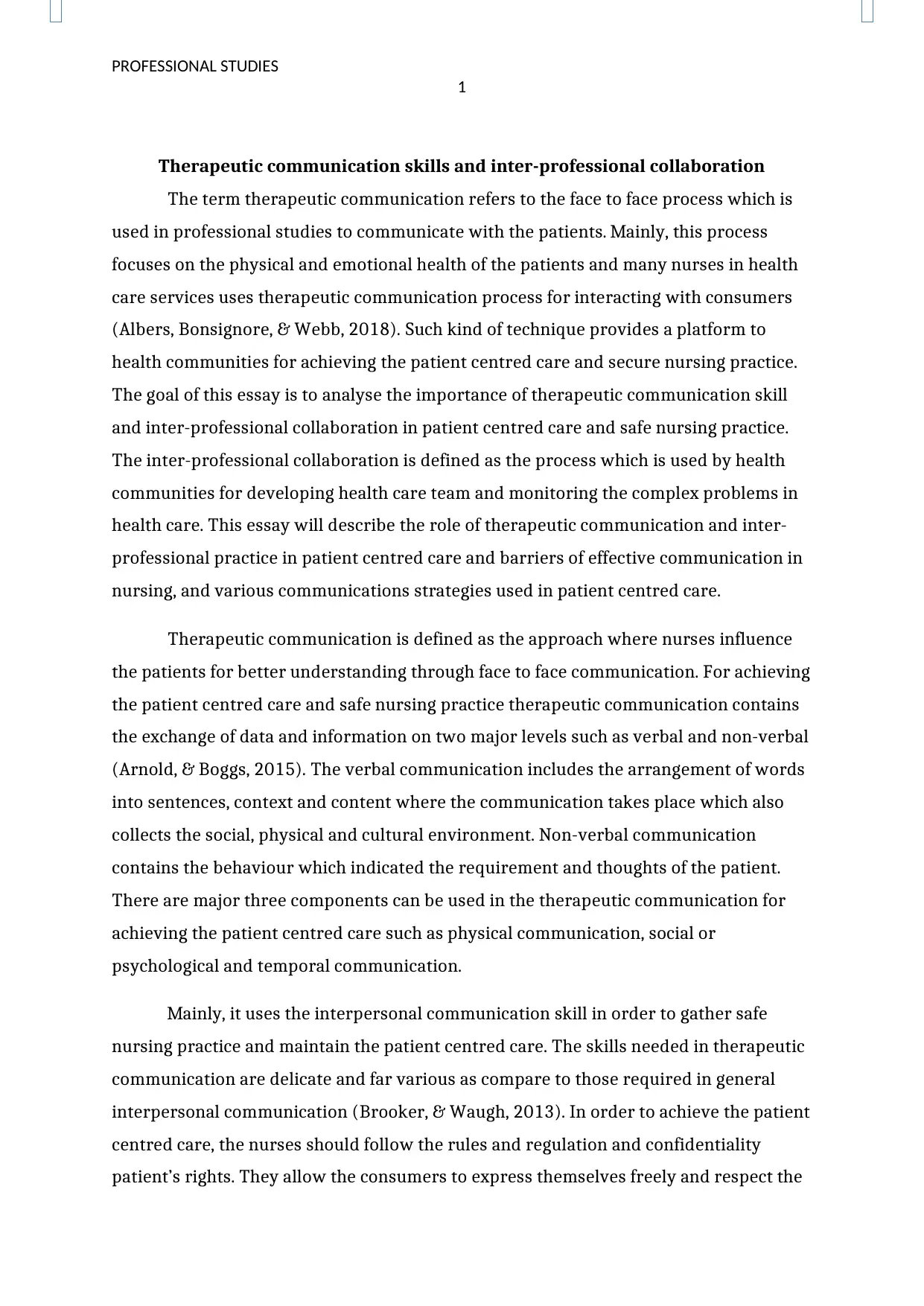
PROFESSIONAL STUDIES
1
Therapeutic communication skills and inter-professional collaboration
The term therapeutic communication refers to the face to face process which is
used in professional studies to communicate with the patients. Mainly, this process
focuses on the physical and emotional health of the patients and many nurses in health
care services uses therapeutic communication process for interacting with consumers
(Albers, Bonsignore, & Webb, 2018). Such kind of technique provides a platform to
health communities for achieving the patient centred care and secure nursing practice.
The goal of this essay is to analyse the importance of therapeutic communication skill
and inter-professional collaboration in patient centred care and safe nursing practice.
The inter-professional collaboration is defined as the process which is used by health
communities for developing health care team and monitoring the complex problems in
health care. This essay will describe the role of therapeutic communication and inter-
professional practice in patient centred care and barriers of effective communication in
nursing, and various communications strategies used in patient centred care.
Therapeutic communication is defined as the approach where nurses influence
the patients for better understanding through face to face communication. For achieving
the patient centred care and safe nursing practice therapeutic communication contains
the exchange of data and information on two major levels such as verbal and non-verbal
(Arnold, & Boggs, 2015). The verbal communication includes the arrangement of words
into sentences, context and content where the communication takes place which also
collects the social, physical and cultural environment. Non-verbal communication
contains the behaviour which indicated the requirement and thoughts of the patient.
There are major three components can be used in the therapeutic communication for
achieving the patient centred care such as physical communication, social or
psychological and temporal communication.
Mainly, it uses the interpersonal communication skill in order to gather safe
nursing practice and maintain the patient centred care. The skills needed in therapeutic
communication are delicate and far various as compare to those required in general
interpersonal communication (Brooker, & Waugh, 2013). In order to achieve the patient
centred care, the nurses should follow the rules and regulation and confidentiality
patient’s rights. They allow the consumers to express themselves freely and respect the
1
Therapeutic communication skills and inter-professional collaboration
The term therapeutic communication refers to the face to face process which is
used in professional studies to communicate with the patients. Mainly, this process
focuses on the physical and emotional health of the patients and many nurses in health
care services uses therapeutic communication process for interacting with consumers
(Albers, Bonsignore, & Webb, 2018). Such kind of technique provides a platform to
health communities for achieving the patient centred care and secure nursing practice.
The goal of this essay is to analyse the importance of therapeutic communication skill
and inter-professional collaboration in patient centred care and safe nursing practice.
The inter-professional collaboration is defined as the process which is used by health
communities for developing health care team and monitoring the complex problems in
health care. This essay will describe the role of therapeutic communication and inter-
professional practice in patient centred care and barriers of effective communication in
nursing, and various communications strategies used in patient centred care.
Therapeutic communication is defined as the approach where nurses influence
the patients for better understanding through face to face communication. For achieving
the patient centred care and safe nursing practice therapeutic communication contains
the exchange of data and information on two major levels such as verbal and non-verbal
(Arnold, & Boggs, 2015). The verbal communication includes the arrangement of words
into sentences, context and content where the communication takes place which also
collects the social, physical and cultural environment. Non-verbal communication
contains the behaviour which indicated the requirement and thoughts of the patient.
There are major three components can be used in the therapeutic communication for
achieving the patient centred care such as physical communication, social or
psychological and temporal communication.
Mainly, it uses the interpersonal communication skill in order to gather safe
nursing practice and maintain the patient centred care. The skills needed in therapeutic
communication are delicate and far various as compare to those required in general
interpersonal communication (Brooker, & Waugh, 2013). In order to achieve the patient
centred care, the nurses should follow the rules and regulation and confidentiality
patient’s rights. They allow the consumers to express themselves freely and respect the
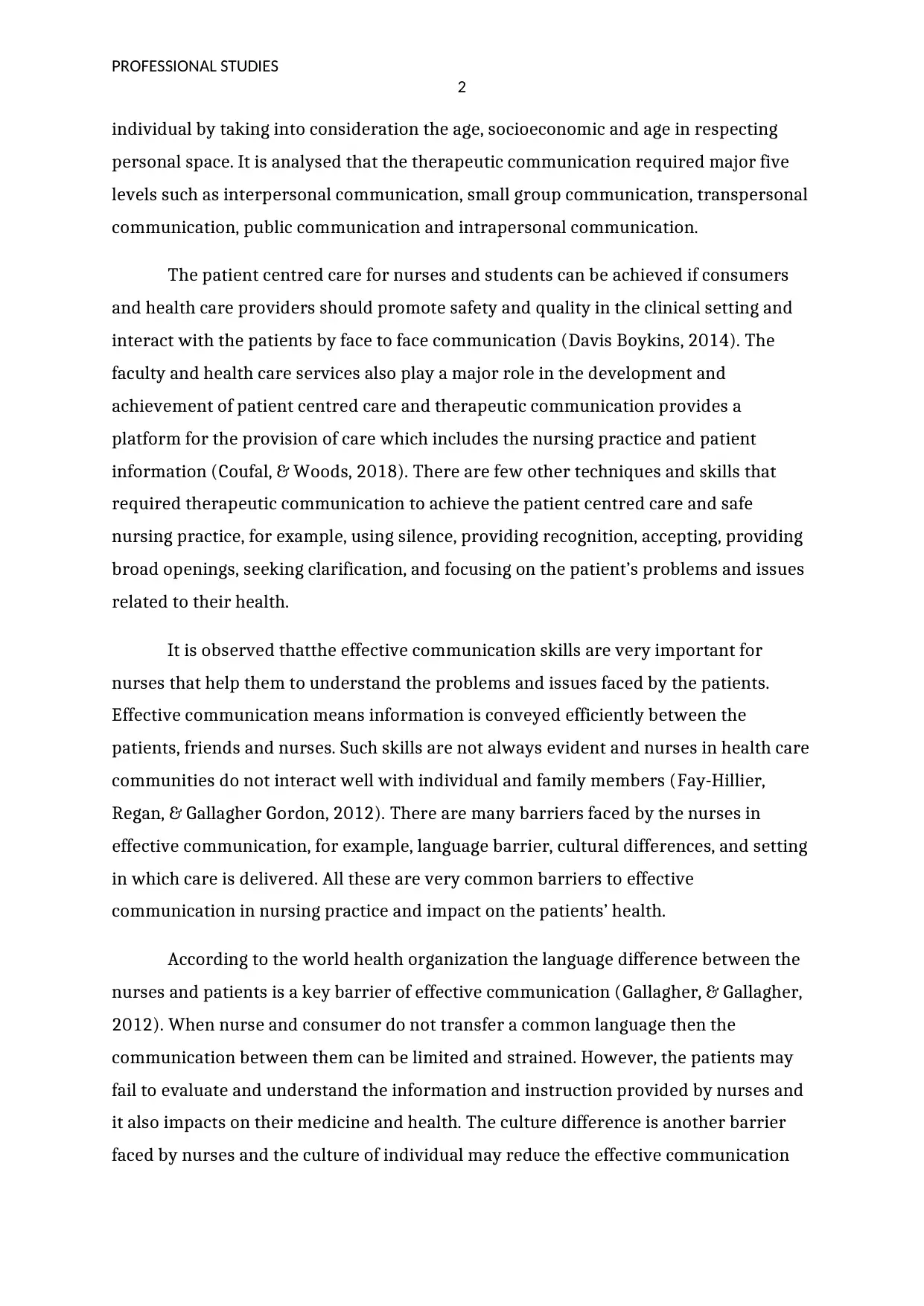
PROFESSIONAL STUDIES
2
individual by taking into consideration the age, socioeconomic and age in respecting
personal space. It is analysed that the therapeutic communication required major five
levels such as interpersonal communication, small group communication, transpersonal
communication, public communication and intrapersonal communication.
The patient centred care for nurses and students can be achieved if consumers
and health care providers should promote safety and quality in the clinical setting and
interact with the patients by face to face communication (Davis Boykins, 2014). The
faculty and health care services also play a major role in the development and
achievement of patient centred care and therapeutic communication provides a
platform for the provision of care which includes the nursing practice and patient
information (Coufal, & Woods, 2018). There are few other techniques and skills that
required therapeutic communication to achieve the patient centred care and safe
nursing practice, for example, using silence, providing recognition, accepting, providing
broad openings, seeking clarification, and focusing on the patient’s problems and issues
related to their health.
It is observed thatthe effective communication skills are very important for
nurses that help them to understand the problems and issues faced by the patients.
Effective communication means information is conveyed efficiently between the
patients, friends and nurses. Such skills are not always evident and nurses in health care
communities do not interact well with individual and family members (Fay-Hillier,
Regan, & Gallagher Gordon, 2012). There are many barriers faced by the nurses in
effective communication, for example, language barrier, cultural differences, and setting
in which care is delivered. All these are very common barriers to effective
communication in nursing practice and impact on the patients’ health.
According to the world health organization the language difference between the
nurses and patients is a key barrier of effective communication (Gallagher, & Gallagher,
2012). When nurse and consumer do not transfer a common language then the
communication between them can be limited and strained. However, the patients may
fail to evaluate and understand the information and instruction provided by nurses and
it also impacts on their medicine and health. The culture difference is another barrier
faced by nurses and the culture of individual may reduce the effective communication
2
individual by taking into consideration the age, socioeconomic and age in respecting
personal space. It is analysed that the therapeutic communication required major five
levels such as interpersonal communication, small group communication, transpersonal
communication, public communication and intrapersonal communication.
The patient centred care for nurses and students can be achieved if consumers
and health care providers should promote safety and quality in the clinical setting and
interact with the patients by face to face communication (Davis Boykins, 2014). The
faculty and health care services also play a major role in the development and
achievement of patient centred care and therapeutic communication provides a
platform for the provision of care which includes the nursing practice and patient
information (Coufal, & Woods, 2018). There are few other techniques and skills that
required therapeutic communication to achieve the patient centred care and safe
nursing practice, for example, using silence, providing recognition, accepting, providing
broad openings, seeking clarification, and focusing on the patient’s problems and issues
related to their health.
It is observed thatthe effective communication skills are very important for
nurses that help them to understand the problems and issues faced by the patients.
Effective communication means information is conveyed efficiently between the
patients, friends and nurses. Such skills are not always evident and nurses in health care
communities do not interact well with individual and family members (Fay-Hillier,
Regan, & Gallagher Gordon, 2012). There are many barriers faced by the nurses in
effective communication, for example, language barrier, cultural differences, and setting
in which care is delivered. All these are very common barriers to effective
communication in nursing practice and impact on the patients’ health.
According to the world health organization the language difference between the
nurses and patients is a key barrier of effective communication (Gallagher, & Gallagher,
2012). When nurse and consumer do not transfer a common language then the
communication between them can be limited and strained. However, the patients may
fail to evaluate and understand the information and instruction provided by nurses and
it also impacts on their medicine and health. The culture difference is another barrier
faced by nurses and the culture of individual may reduce the effective communication
⊘ This is a preview!⊘
Do you want full access?
Subscribe today to unlock all pages.

Trusted by 1+ million students worldwide
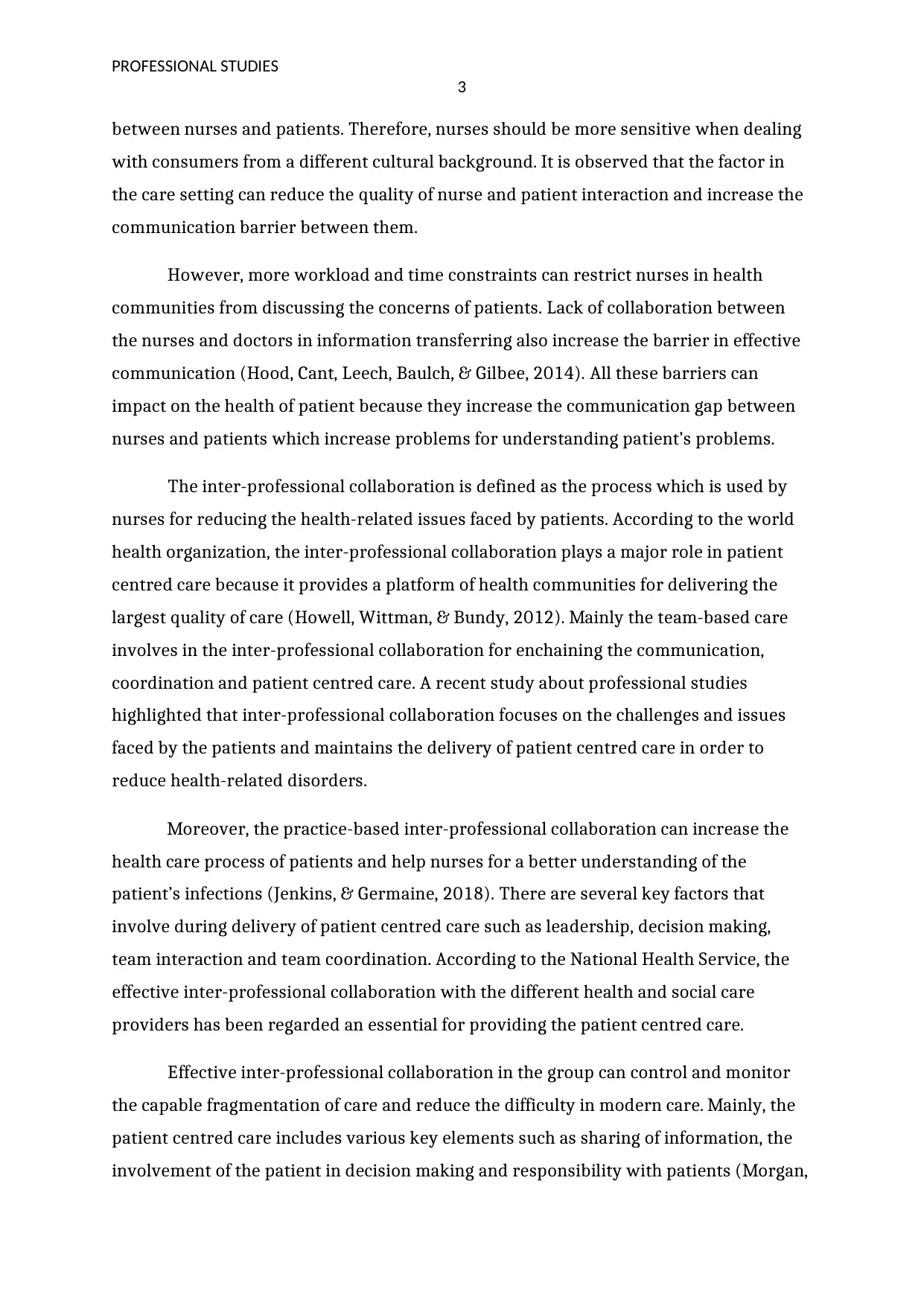
PROFESSIONAL STUDIES
3
between nurses and patients. Therefore, nurses should be more sensitive when dealing
with consumers from a different cultural background. It is observed that the factor in
the care setting can reduce the quality of nurse and patient interaction and increase the
communication barrier between them.
However, more workload and time constraints can restrict nurses in health
communities from discussing the concerns of patients. Lack of collaboration between
the nurses and doctors in information transferring also increase the barrier in effective
communication (Hood, Cant, Leech, Baulch, & Gilbee, 2014). All these barriers can
impact on the health of patient because they increase the communication gap between
nurses and patients which increase problems for understanding patient’s problems.
The inter-professional collaboration is defined as the process which is used by
nurses for reducing the health-related issues faced by patients. According to the world
health organization, the inter-professional collaboration plays a major role in patient
centred care because it provides a platform of health communities for delivering the
largest quality of care (Howell, Wittman, & Bundy, 2012). Mainly the team-based care
involves in the inter-professional collaboration for enchaining the communication,
coordination and patient centred care. A recent study about professional studies
highlighted that inter-professional collaboration focuses on the challenges and issues
faced by the patients and maintains the delivery of patient centred care in order to
reduce health-related disorders.
Moreover, the practice-based inter-professional collaboration can increase the
health care process of patients and help nurses for a better understanding of the
patient’s infections (Jenkins, & Germaine, 2018). There are several key factors that
involve during delivery of patient centred care such as leadership, decision making,
team interaction and team coordination. According to the National Health Service, the
effective inter-professional collaboration with the different health and social care
providers has been regarded an essential for providing the patient centred care.
Effective inter-professional collaboration in the group can control and monitor
the capable fragmentation of care and reduce the difficulty in modern care. Mainly, the
patient centred care includes various key elements such as sharing of information, the
involvement of the patient in decision making and responsibility with patients (Morgan,
3
between nurses and patients. Therefore, nurses should be more sensitive when dealing
with consumers from a different cultural background. It is observed that the factor in
the care setting can reduce the quality of nurse and patient interaction and increase the
communication barrier between them.
However, more workload and time constraints can restrict nurses in health
communities from discussing the concerns of patients. Lack of collaboration between
the nurses and doctors in information transferring also increase the barrier in effective
communication (Hood, Cant, Leech, Baulch, & Gilbee, 2014). All these barriers can
impact on the health of patient because they increase the communication gap between
nurses and patients which increase problems for understanding patient’s problems.
The inter-professional collaboration is defined as the process which is used by
nurses for reducing the health-related issues faced by patients. According to the world
health organization, the inter-professional collaboration plays a major role in patient
centred care because it provides a platform of health communities for delivering the
largest quality of care (Howell, Wittman, & Bundy, 2012). Mainly the team-based care
involves in the inter-professional collaboration for enchaining the communication,
coordination and patient centred care. A recent study about professional studies
highlighted that inter-professional collaboration focuses on the challenges and issues
faced by the patients and maintains the delivery of patient centred care in order to
reduce health-related disorders.
Moreover, the practice-based inter-professional collaboration can increase the
health care process of patients and help nurses for a better understanding of the
patient’s infections (Jenkins, & Germaine, 2018). There are several key factors that
involve during delivery of patient centred care such as leadership, decision making,
team interaction and team coordination. According to the National Health Service, the
effective inter-professional collaboration with the different health and social care
providers has been regarded an essential for providing the patient centred care.
Effective inter-professional collaboration in the group can control and monitor
the capable fragmentation of care and reduce the difficulty in modern care. Mainly, the
patient centred care includes various key elements such as sharing of information, the
involvement of the patient in decision making and responsibility with patients (Morgan,
Paraphrase This Document
Need a fresh take? Get an instant paraphrase of this document with our AI Paraphraser
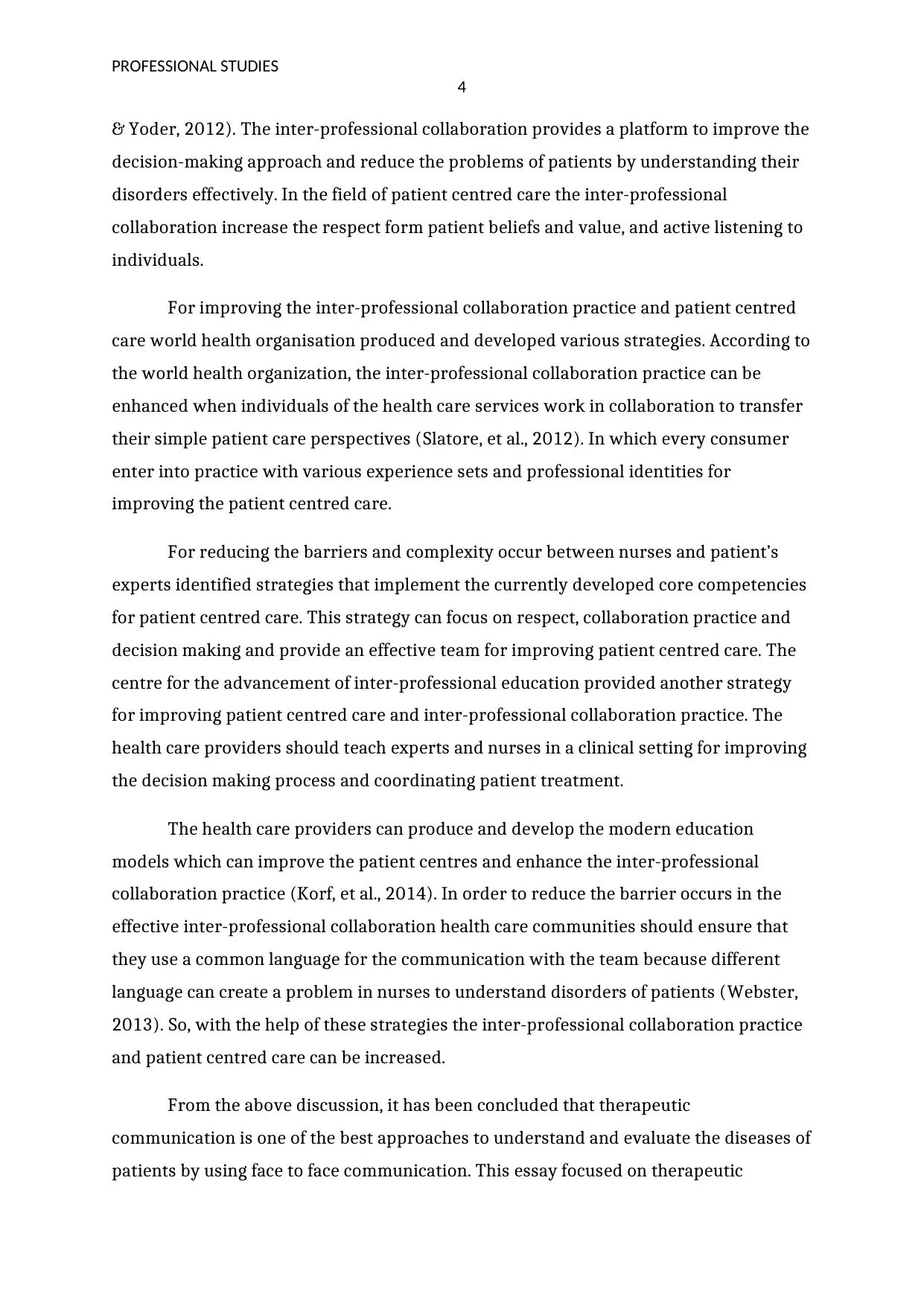
PROFESSIONAL STUDIES
4
& Yoder, 2012). The inter-professional collaboration provides a platform to improve the
decision-making approach and reduce the problems of patients by understanding their
disorders effectively. In the field of patient centred care the inter-professional
collaboration increase the respect form patient beliefs and value, and active listening to
individuals.
For improving the inter-professional collaboration practice and patient centred
care world health organisation produced and developed various strategies. According to
the world health organization, the inter-professional collaboration practice can be
enhanced when individuals of the health care services work in collaboration to transfer
their simple patient care perspectives (Slatore, et al., 2012). In which every consumer
enter into practice with various experience sets and professional identities for
improving the patient centred care.
For reducing the barriers and complexity occur between nurses and patient’s
experts identified strategies that implement the currently developed core competencies
for patient centred care. This strategy can focus on respect, collaboration practice and
decision making and provide an effective team for improving patient centred care. The
centre for the advancement of inter-professional education provided another strategy
for improving patient centred care and inter-professional collaboration practice. The
health care providers should teach experts and nurses in a clinical setting for improving
the decision making process and coordinating patient treatment.
The health care providers can produce and develop the modern education
models which can improve the patient centres and enhance the inter-professional
collaboration practice (Korf, et al., 2014). In order to reduce the barrier occurs in the
effective inter-professional collaboration health care communities should ensure that
they use a common language for the communication with the team because different
language can create a problem in nurses to understand disorders of patients (Webster,
2013). So, with the help of these strategies the inter-professional collaboration practice
and patient centred care can be increased.
From the above discussion, it has been concluded that therapeutic
communication is one of the best approaches to understand and evaluate the diseases of
patients by using face to face communication. This essay focused on therapeutic
4
& Yoder, 2012). The inter-professional collaboration provides a platform to improve the
decision-making approach and reduce the problems of patients by understanding their
disorders effectively. In the field of patient centred care the inter-professional
collaboration increase the respect form patient beliefs and value, and active listening to
individuals.
For improving the inter-professional collaboration practice and patient centred
care world health organisation produced and developed various strategies. According to
the world health organization, the inter-professional collaboration practice can be
enhanced when individuals of the health care services work in collaboration to transfer
their simple patient care perspectives (Slatore, et al., 2012). In which every consumer
enter into practice with various experience sets and professional identities for
improving the patient centred care.
For reducing the barriers and complexity occur between nurses and patient’s
experts identified strategies that implement the currently developed core competencies
for patient centred care. This strategy can focus on respect, collaboration practice and
decision making and provide an effective team for improving patient centred care. The
centre for the advancement of inter-professional education provided another strategy
for improving patient centred care and inter-professional collaboration practice. The
health care providers should teach experts and nurses in a clinical setting for improving
the decision making process and coordinating patient treatment.
The health care providers can produce and develop the modern education
models which can improve the patient centres and enhance the inter-professional
collaboration practice (Korf, et al., 2014). In order to reduce the barrier occurs in the
effective inter-professional collaboration health care communities should ensure that
they use a common language for the communication with the team because different
language can create a problem in nurses to understand disorders of patients (Webster,
2013). So, with the help of these strategies the inter-professional collaboration practice
and patient centred care can be increased.
From the above discussion, it has been concluded that therapeutic
communication is one of the best approaches to understand and evaluate the diseases of
patients by using face to face communication. This essay focused on therapeutic
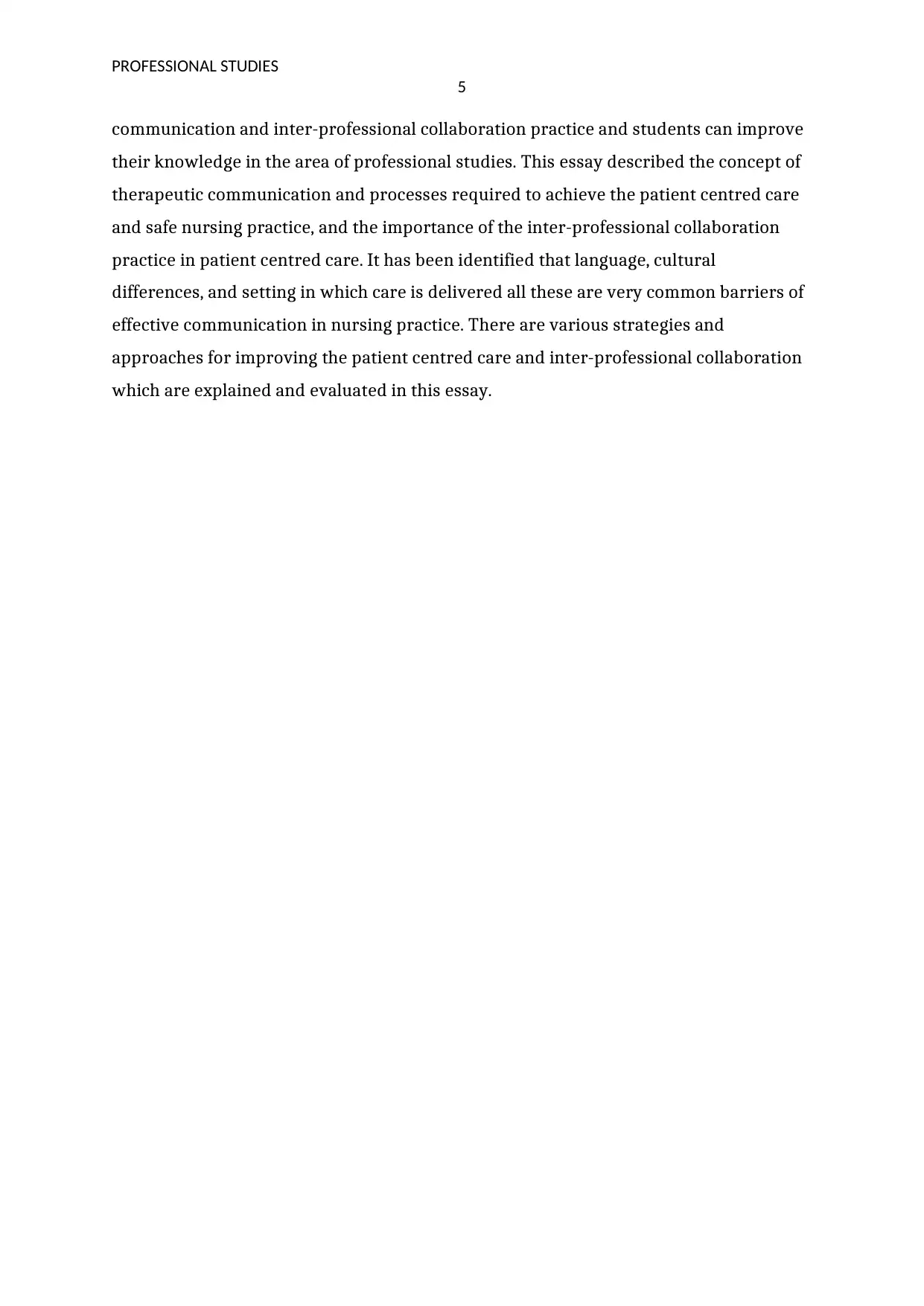
PROFESSIONAL STUDIES
5
communication and inter-professional collaboration practice and students can improve
their knowledge in the area of professional studies. This essay described the concept of
therapeutic communication and processes required to achieve the patient centred care
and safe nursing practice, and the importance of the inter-professional collaboration
practice in patient centred care. It has been identified that language, cultural
differences, and setting in which care is delivered all these are very common barriers of
effective communication in nursing practice. There are various strategies and
approaches for improving the patient centred care and inter-professional collaboration
which are explained and evaluated in this essay.
5
communication and inter-professional collaboration practice and students can improve
their knowledge in the area of professional studies. This essay described the concept of
therapeutic communication and processes required to achieve the patient centred care
and safe nursing practice, and the importance of the inter-professional collaboration
practice in patient centred care. It has been identified that language, cultural
differences, and setting in which care is delivered all these are very common barriers of
effective communication in nursing practice. There are various strategies and
approaches for improving the patient centred care and inter-professional collaboration
which are explained and evaluated in this essay.
⊘ This is a preview!⊘
Do you want full access?
Subscribe today to unlock all pages.

Trusted by 1+ million students worldwide
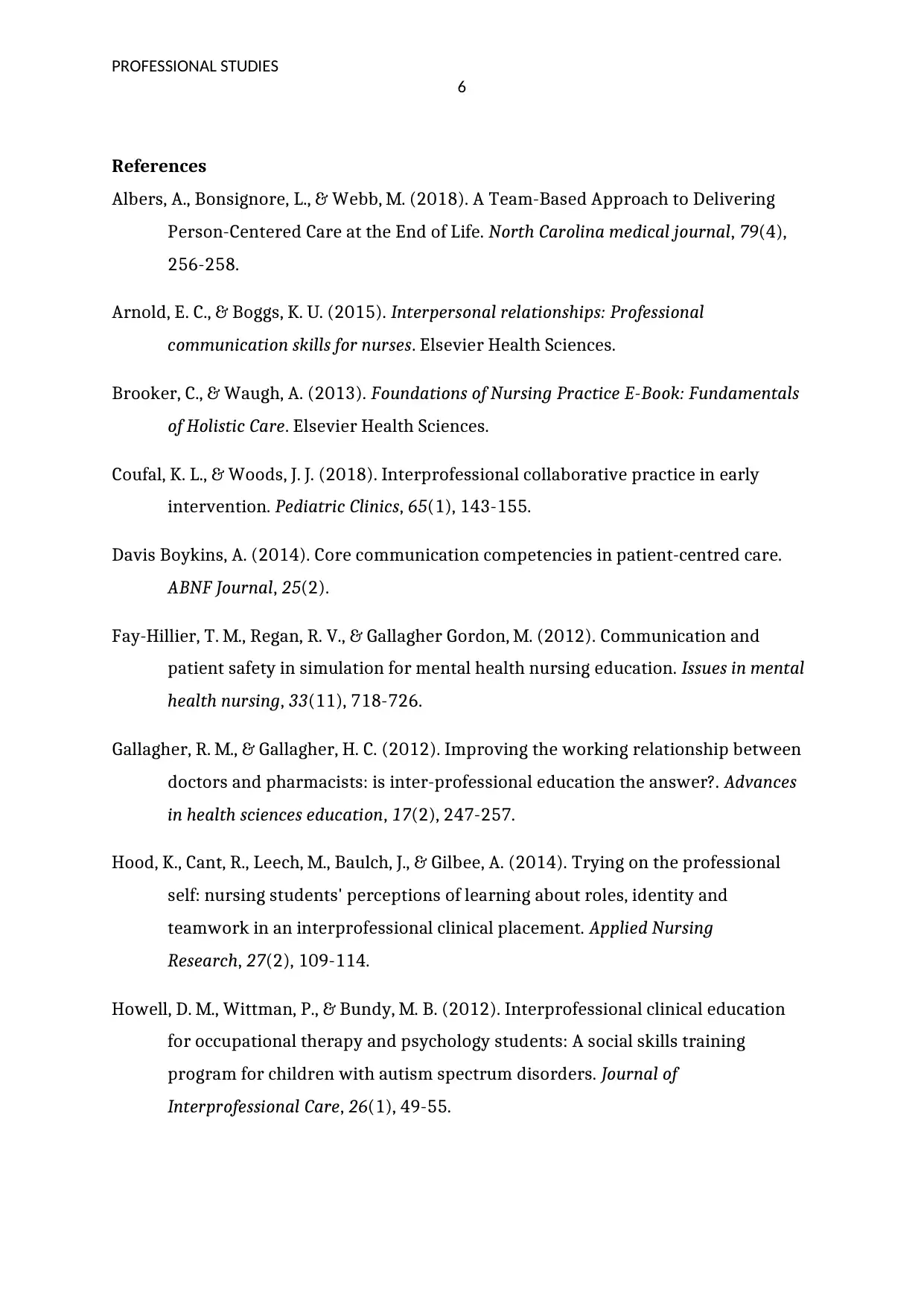
PROFESSIONAL STUDIES
6
References
Albers, A., Bonsignore, L., & Webb, M. (2018). A Team-Based Approach to Delivering
Person-Centered Care at the End of Life. North Carolina medical journal, 79(4),
256-258.
Arnold, E. C., & Boggs, K. U. (2015). Interpersonal relationships: Professional
communication skills for nurses. Elsevier Health Sciences.
Brooker, C., & Waugh, A. (2013). Foundations of Nursing Practice E-Book: Fundamentals
of Holistic Care. Elsevier Health Sciences.
Coufal, K. L., & Woods, J. J. (2018). Interprofessional collaborative practice in early
intervention. Pediatric Clinics, 65(1), 143-155.
Davis Boykins, A. (2014). Core communication competencies in patient-centred care.
ABNF Journal, 25(2).
Fay-Hillier, T. M., Regan, R. V., & Gallagher Gordon, M. (2012). Communication and
patient safety in simulation for mental health nursing education. Issues in mental
health nursing, 33(11), 718-726.
Gallagher, R. M., & Gallagher, H. C. (2012). Improving the working relationship between
doctors and pharmacists: is inter-professional education the answer?. Advances
in health sciences education, 17(2), 247-257.
Hood, K., Cant, R., Leech, M., Baulch, J., & Gilbee, A. (2014). Trying on the professional
self: nursing students' perceptions of learning about roles, identity and
teamwork in an interprofessional clinical placement. Applied Nursing
Research, 27(2), 109-114.
Howell, D. M., Wittman, P., & Bundy, M. B. (2012). Interprofessional clinical education
for occupational therapy and psychology students: A social skills training
program for children with autism spectrum disorders. Journal of
Interprofessional Care, 26(1), 49-55.
6
References
Albers, A., Bonsignore, L., & Webb, M. (2018). A Team-Based Approach to Delivering
Person-Centered Care at the End of Life. North Carolina medical journal, 79(4),
256-258.
Arnold, E. C., & Boggs, K. U. (2015). Interpersonal relationships: Professional
communication skills for nurses. Elsevier Health Sciences.
Brooker, C., & Waugh, A. (2013). Foundations of Nursing Practice E-Book: Fundamentals
of Holistic Care. Elsevier Health Sciences.
Coufal, K. L., & Woods, J. J. (2018). Interprofessional collaborative practice in early
intervention. Pediatric Clinics, 65(1), 143-155.
Davis Boykins, A. (2014). Core communication competencies in patient-centred care.
ABNF Journal, 25(2).
Fay-Hillier, T. M., Regan, R. V., & Gallagher Gordon, M. (2012). Communication and
patient safety in simulation for mental health nursing education. Issues in mental
health nursing, 33(11), 718-726.
Gallagher, R. M., & Gallagher, H. C. (2012). Improving the working relationship between
doctors and pharmacists: is inter-professional education the answer?. Advances
in health sciences education, 17(2), 247-257.
Hood, K., Cant, R., Leech, M., Baulch, J., & Gilbee, A. (2014). Trying on the professional
self: nursing students' perceptions of learning about roles, identity and
teamwork in an interprofessional clinical placement. Applied Nursing
Research, 27(2), 109-114.
Howell, D. M., Wittman, P., & Bundy, M. B. (2012). Interprofessional clinical education
for occupational therapy and psychology students: A social skills training
program for children with autism spectrum disorders. Journal of
Interprofessional Care, 26(1), 49-55.
Paraphrase This Document
Need a fresh take? Get an instant paraphrase of this document with our AI Paraphraser
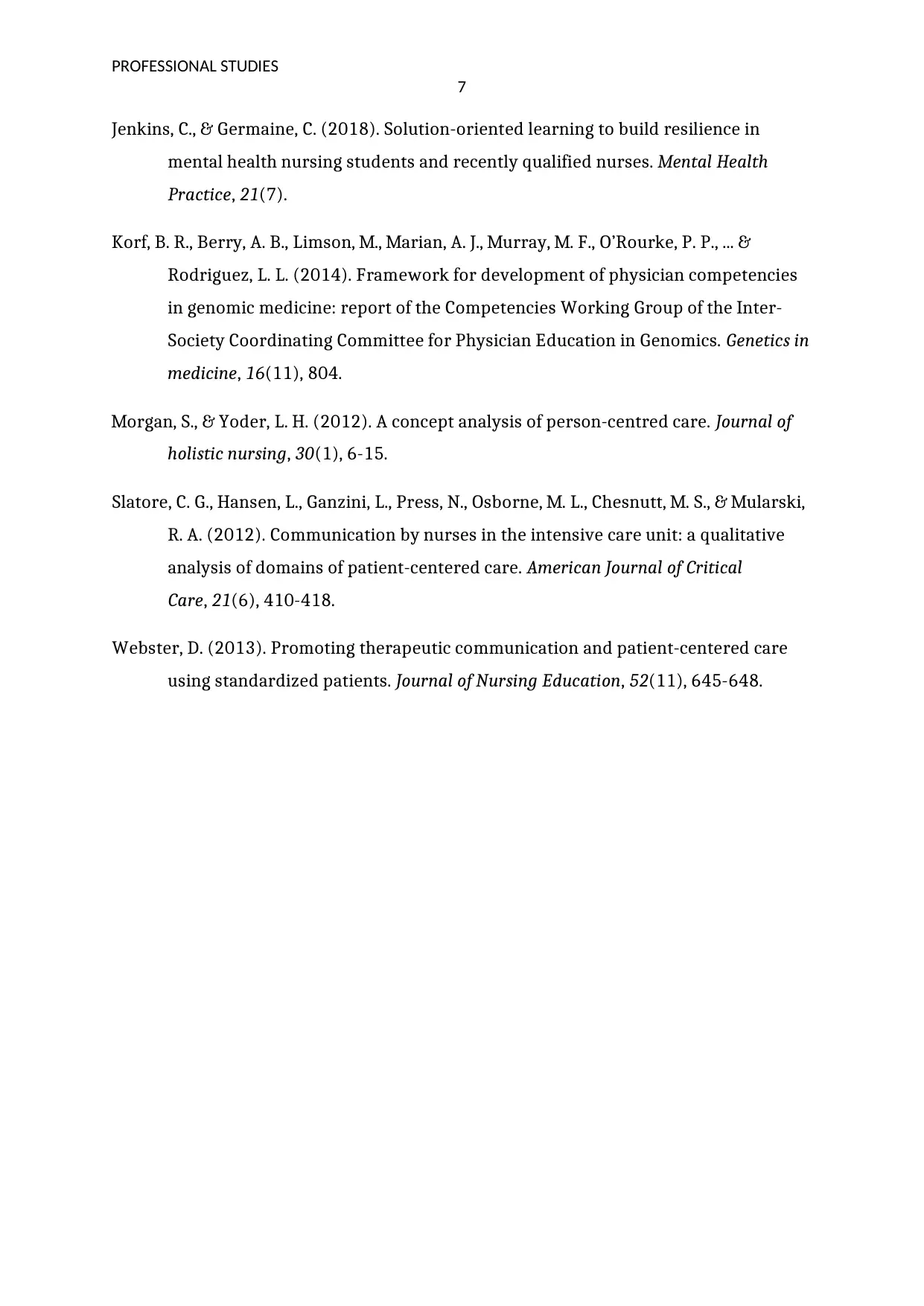
PROFESSIONAL STUDIES
7
Jenkins, C., & Germaine, C. (2018). Solution-oriented learning to build resilience in
mental health nursing students and recently qualified nurses. Mental Health
Practice, 21(7).
Korf, B. R., Berry, A. B., Limson, M., Marian, A. J., Murray, M. F., O’Rourke, P. P., ... &
Rodriguez, L. L. (2014). Framework for development of physician competencies
in genomic medicine: report of the Competencies Working Group of the Inter-
Society Coordinating Committee for Physician Education in Genomics. Genetics in
medicine, 16(11), 804.
Morgan, S., & Yoder, L. H. (2012). A concept analysis of person-centred care. Journal of
holistic nursing, 30(1), 6-15.
Slatore, C. G., Hansen, L., Ganzini, L., Press, N., Osborne, M. L., Chesnutt, M. S., & Mularski,
R. A. (2012). Communication by nurses in the intensive care unit: a qualitative
analysis of domains of patient-centered care. American Journal of Critical
Care, 21(6), 410-418.
Webster, D. (2013). Promoting therapeutic communication and patient-centered care
using standardized patients. Journal of Nursing Education, 52(11), 645-648.
7
Jenkins, C., & Germaine, C. (2018). Solution-oriented learning to build resilience in
mental health nursing students and recently qualified nurses. Mental Health
Practice, 21(7).
Korf, B. R., Berry, A. B., Limson, M., Marian, A. J., Murray, M. F., O’Rourke, P. P., ... &
Rodriguez, L. L. (2014). Framework for development of physician competencies
in genomic medicine: report of the Competencies Working Group of the Inter-
Society Coordinating Committee for Physician Education in Genomics. Genetics in
medicine, 16(11), 804.
Morgan, S., & Yoder, L. H. (2012). A concept analysis of person-centred care. Journal of
holistic nursing, 30(1), 6-15.
Slatore, C. G., Hansen, L., Ganzini, L., Press, N., Osborne, M. L., Chesnutt, M. S., & Mularski,
R. A. (2012). Communication by nurses in the intensive care unit: a qualitative
analysis of domains of patient-centered care. American Journal of Critical
Care, 21(6), 410-418.
Webster, D. (2013). Promoting therapeutic communication and patient-centered care
using standardized patients. Journal of Nursing Education, 52(11), 645-648.
1 out of 8
Related Documents
Your All-in-One AI-Powered Toolkit for Academic Success.
+13062052269
info@desklib.com
Available 24*7 on WhatsApp / Email
![[object Object]](/_next/static/media/star-bottom.7253800d.svg)
Unlock your academic potential
Copyright © 2020–2025 A2Z Services. All Rights Reserved. Developed and managed by ZUCOL.





